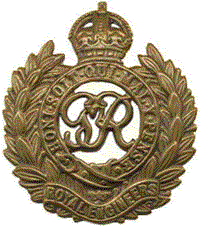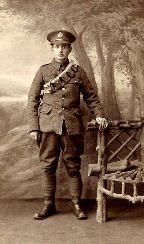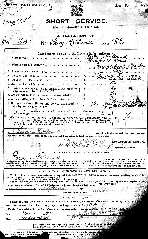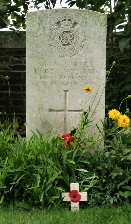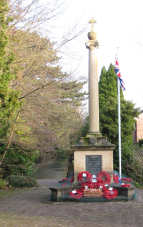
|
| HOME PAGE |
| MEMORIAL CROSS |
| HISTORY of the CROSS |
| ROLL of HONOUR |
| LINKS |
Percy Molland was born in 1886 in Hollocombe in the parish of Winkleigh. His father Richard had married Bessie Ellen Lawrence in 1882 and eventually had five children. Their eldest child was Blanche (born 1882), then Lawrence (1884) and after Percy his two younger brothers Archibald (1888) and Hadland (1891). Richard came from a family in Ashreigney and his father, James, an agricultural labourer moving to Hollacome in 1850. Bessie’s parents also came from Ashreigney. Richard had the benefit of an apprenticeship and went on to become a carpenter and wheelwright. This seems to have benefited this very close family whose children were well educated. Blanche became the assistant teacher in Hollacombe School, while Lawrence (Laurie), Percy and Archibald were able to join the General Post Office. While Percy was growing up, there were many cousins and his grandmother all living around Hollocombe as well as other branches of the Mollands who may have been related. Like his sister and brothers, Percy attended the Hollocombe School until the age of 14 and was employed first at Winkleigh Post Office run by the Postmistress, Mrs. Friend. A large number of family postcards have survived, from which we learn that from Winkleigh he moved to South Molton, where he was in June 1905 when his address was c/o Mrs. Milton, 56 South Street. After many moves, and passing his Sorting Clerk and Telegraphist examination, he was able to choose a posting from a short list of post offices out of which he picked Hungerford, as it was the nearest to Devon He was living there when the war broke out in 1914. He is recorded in the 1911 census as living as a boarder in Fair View Road, in the house of Marian Waddington, a widow of 54, with her daughter Winifred, a school teacher. A postcard dated Hungerford 6.7.1914 to his niece Iris, (Lawrence’s daughter) aged 2 and signed Percie (a spelling he used on the postcards from when he was 20), shows that Archie had already enlisted and was soon to be called up into the Royal Engineers to serve in the Postal and Telegraphic services, surviving the war. Archie’s enlistment possibly encouraged Percy to follow suit. ‘Make the most of Uncle Arch’, he writes, ‘because you won’t probably see him for some time’. It was about this time that Percy had become very friendly with, if not engaged to, a lady named Pearl. A birthday postcard from her, also to Iris, reads ‘Very much love to the little maid I’ve heard so much about’. We are extremely fortunate that Percy Molland’s army record papers are among the small minority of those that survived the London blitz in WWII, and these, together with his medal record card, allow us to trace the full story of his war service and his death from the Spanish ’flu on the last day of the war. They are referred to in the text by number, with the prefix M as [M4]; clicking on these numbers displays a image of that document. Alternatively, all the documents can be seen on one page by clicking HERE or by clicking the Army Records thumbnail on the right. At the age of 28 and 5 months Percy enlisted on the 19th April 1915 as number 36165 in the Royal Engineers at Newbury, Buckinghamshire [M2]. When he joined he had a letter for the Recruiting Officer from the Colonel, Director of Army Signals which reads: ’I have been requested by the Officer in Charge Royal Engineers’ Records to send you Mr. Molland, a Post Office servant, for enlistment under A.O.296 and 341 of 1914 as an Office Telegraphist in the Royal Engineers (Regular Army) if he is eligible in all respects. Will you kindly send the recruit at once with this letter to the Officer Commanding, Reserve Signal Company, Aldershot, and forward the attestation to the same officer.’ [M1]There was an Army procedure that if there was a shortage of men in the Army with particular trades or qualifications, then anyone with those trades or qualifications could apply in advance and would be given a position to permit them to work at their trade or qualification. By early 1915, Percy would have known that casualties were much higher than expected, and that if he was called up, he could easily be sent to the front line. As the Army was short of qualified telegraphists Percy’s qualification made him eligible for the Army procedure to enable him to secure a position that would be relatively safe. As this would had been set up in advance, when he enlisted he could be processed and posted immediately. When Percy enlisted, he was given a medical examination [M4], where we learn of his medical condition at this time: height 5ft 5˝ inches, weight 9 stone, chest 35˝ inches including 2˝ inches expansion. His vision was excellent, and he had been vaccinated five times by his caring family, 3 times in infancy and twice later. He was given the rank of Sapper in the Royal Engineers as an Office Telegraphist and immediately posted to Aldershot.[M5] On the 21st he took and passed the proficiency test for the Telegraph Office [M6], and had his position in the Army confirmed on the 22nd [M2], whereupon he started his fast track basic training prior to his active posting He appears to have moved from place to place for this; a postcard showing the Bull Ring Birmingham dated 1.5.1915 posted from High Wycombe to Adeline Banks (of whom Percy was very fond and who looked after Lawrence’s wife for most of her childhood) gives us the news of two moves: ‘Am now here in Billets and good ones. With a Devonshire family so it is all right. Having a good time on the whole. Moving to Fenny Stratford next Friday. Seeing a bit of the country.’Thus, he should have arrived there on the 7th of May.The R. E. Fenny Stratford Depôt was the place from which Percy’s posting was to take place. On the 20th May 1915, he was posted to and arrived in France [M5], [M14] and [M15] together with reference to the Medal Card] to join G.H.Q. A postcard sent to Lawrence from Dieppe postmarked 28th May containing only the word ‘Love. P.’ shows his safe arrival, though it took a week to be processed. All troops arriving in France were warned not to send open postcards home (apart from the army field-service cards), and of the need for security and the severe penalties attached to giving information that might be picked up by enemy spies. Too busy to write a letter, Percy took no chances of being identified. After a three days journey, via the Royal Engineers Signal Reserve Depot at Abbeville, he arrived on 24th May in the Lines of Communication Company at Sir John French’s General Headquarters, at that time stationed at St. Omer.[M7] In March 1916 Sir Douglas Haig who became GOC after the Battle of Loos in September 1915 moved his Headquarters to Montreuil to be more centrally located behind the growing length of British-held front. The French army barracks in the town, together with a number of public buildings, were taken over and it was here that Percy Molland was stationed from that time. Prior to 1920 when the Royal Corps of Signals was established, responsibility for signalling with the British Army lay with the Royal Corps of Engineers. ‘L’ Signal Company, the equivalent of the civilian General Post Office, was responsible for handling the telephone and telegraphic communications and message carrying by motor-cycle between GHQ and the various Army Headquarters on all parts of the front. From the Army GHQs communication was maintained with the various Corps Headquarters, from Corps to Divisions, from Divisions to Brigades and finally from Brigades to Battalions. Connections were also maintained between G.H.Q. and London and Paris. The growth in the Signal Services during the war was phenomenal. In August 1914 GHQ ‘L’ Signal Company originally consisted of no more than 5 Officers and 268 ORs on a meagre establishment of 22 horses, 2 carts, 1 wagon, 3 cars, 9 bicycles and 16 motor bicycles. As the army grew, so did the number of units on the lines of communication and the volume of administrative traffic. Specially selected men such as Percy Molland were required to increase the manpower of ‘L’ Signal Company culminating by the end of the war in its organisation on a Battalion basis. Already by November 1916 the name had changed to ‘L’ Signal Battalion, consisting of 30 Officers and an establishment of 1773 ORs. By November 1917 ‘L’ Signal Battalion had expanded to 54 Officers and 2.380 ORs. Further increases brought numbers in August 1918 to 100 Officers and 3358 ORs with the absorption of the G.H.Q. Signal Company into a single unit. Finally with the renewal of mobile warfare in the last 100 days ‘L’ Signal Company increased to 110 Officers and 4102 ORs. Of course, not all of this huge establishment were stationed at Montreuil. The Lines of Communication area comprised all that between the ports and the various Army headquarters and eventually contained the equivalent of about 1500 miles of 20-wire routes, supported by road and rail communications. In the telegraph offices at G.H.Q. itself the combined daily traffic at the end of the war averaged some 23,000 telegrams and 2,250 packets, to which must be added for the G.H.Q. Signals Company a further 9,000 telegrams and 3,400 packets. For the technically minded we can record that the telegraph equipment comprised the General Post Office pattern hand-speed sounder, as incorporated in the various simplex, duplex and quadruplex instruments, and the high-speed Wheatstone automatic. Telephone equipment was all of the magneto type. By 1916 the ‘concentrator’ was introduced, by which means a multiple address message could be sent simultaneously by one operator to several out-stations using a plug and socket device. Other modifications improved speech communications, but further down the communication lines from Army to Corps to Divisions and Brigades, telephone communication was far from secure. In spite of every effort there is no doubt that the British Army lagged far behind German technical superiority that gave them foreknowledge of British plans and communications. On both sides of course in a battle area elaborate telegraph and telephone communications were liable to break-down as cables were cut by shell fire, runners and flag signallers killed, pigeons shot down and often eaten. Further back, field telephones could be tapped, giving away vital intelligence, because of interception of the field telephone and telegraph traffic with listening devices. The British army was slow to copy the German techniques of listening devices on the British and French telephone cables; even by July 1916 and the opening of the Battle of the Somme there were only 5 listening sets on the entire Western Front. These were known as ‘I Toc’ sets (Intelligence Telephone Sets). By contrast virtually all British telegraph and telephone messages were intercepted by the Germans, giving away all information on the Order of Battle, the disposition of every unit, the casualty figures and supply requirements and so on. Eventually, towards the end of 1916 ‘Fuller Phones’ were introduced, different in the way they were able to use a very weak signal, much more difficult to intercept. Such was its success that the Fullerphone remained in service throughout WWII and became obsolete only in the 1950’s. Percy Molland would certainly have understood the reasoning behind this new development. It is less likely that he would have realised a second technique that developed as the war progressed, the use of false information that we knew would be intercepted. The most important example of this occurred in August 1918 in the preparations for the Amiens campaign by Canadian and Australian troops. The Germans were deceived into believing that the expected main offensive would be launched in the Ypres sector and as a result the Germans were taken by a complete surprise. With all these technical developments, and living at G.H.Q., Percy Molland’s war was relatively comfortable and safe, and had he lived the experience that he had gained in the army signals service would have greatly enhanced his chances of future promotion, when he would have rejoined the Post Office telegraphic service after the war. The preserved documents in the National Archives give details of his service record [M7], in what was called the ‘Casualty Form’. Percy must have felt an enhancement to his career when on 19th April 1917 he was awarded the General Communications Badge, First Class. There is a record of one misdemeanour. On 12th June 1916 he made the mistake of entering a café during prohibited hours, presumably staying out late after a visit to a local estaminet. For this offence and merely under ‘open arrest’ (not locked up in the Guard Room) he forfeited 3 days’ pay! Home leave of course was desired by all, but for the ORs it was a rare blessing. Percy’s first leave was for 10 days, happily over Christmas, from 20th to 30th December 1916. He then had to wait for two years until 16th January 1918 before enjoying a second leave, this time of 14 days. He spent the first week of his leave at Ilfracombe, with Archie. A postcard dated Ilfracombe 25.01.18 to Lawrence at Ottery St. Mary reads: ‘Wishing you the best of birthday wishes old man. Shall be seeing you soon either way. Love to ye all yrs Percie’. There is an addition on the card – ‘Same as above Arch’. It was to be the last time that he saw his parents, his beloved brothers and sister and little Iris. On 21st of March 1918 the Germans launched their final huge effort of the war, the ‘Kaiserschlaft’, and one can imagine the sense of panic and increase in the work load at GHQ ‘L’ Signals, with everyone at home worried about Percy’s safety. An Easter post card from Lawrence dated 31.03.1918 to little Iris (spending Easter at Holmleigh in Hollacombe with her grandparents Richard and Bessie) includes: Sometime in late October or early November 1918 Percy fell victim to the Spanish ’flu epidemic that swept through all the armies on the Western Front, friend and foe alike, and was soon carried back to England. The 1918 “Spanish” ’flu pandemic is estimated to have infected up to one billion people - half the world’s population at the time, and killing more people than any other single outbreak of disease in world history, surpassing even the Black Death of the Middle Ages. Although it probably originated in the Far East, it was dubbed “Spanish” ’flu because the press in Spain - not being involved in the Great War - were the first to report extensively on its impact. The virus caused three waves of disease. In the first wave which seems to have originated in late 1917, the early ’flu symptoms were little different from normal types of winter ’flu, and most people who were infected with the virus recovered within a week following bed rest, although a small minority died within 24 hours of infection. The second wave, between September and December 1918, brought a version of the disease that was much more virulent, and resulted in the heaviest loss of life. For Percy, living in a crowded barracks and in an office location there was little chance of isolating the epidemic, and few at the General Headquarters would have realised until it was too late how serious a disease it was, with, as in Percy’s case, death often resulting from pleurisy. More detailed information regarding the origins and spread of the disease can be found in the Related Topic link on the right. The documents reveal the full story of Percy’s death. Falling sick a day or two before, he was admitted to the 6th General Hospital at Fillievres on 31st October [M9], where he lived for a further 11 days. As with so many, a partial recovery was followed by the onset of pleurisy and a telegram sent on 10th November [M10] informing the family that he was now dangerously ill, and that permission to visit him was refused. The family, or rather in all probability Lawrence, had requested permission to travel over to France, a privilege granted very seldom and then only to the next of kin of officers, that is, to those with both money and influence. It is typical of the Molland family that they would have made every effort to do so. The end came quickly, and Percy may have died before the previous telegram had been received. Two telegrams [M12] and [M13], one giving the date of his death, 11th November 1918, the very last day of the war. One of the telegrams shows the figure 11 possibly followed by"am", which could be the time of death, poignantly the very last moment of the war, which has been reported within the village of Winkleigh. He had served for a total of 3 years and 204 days [M15]. Fillievres is a village situated some 20 miles (32 km) southeast of Montreuil on the D340 road out of Hesdin, a short journey by motor-ambulance from GHQ. In June 1918 the village, or rather an area known as Delsaux Farm, was originally the site of the 46th Casualty Clearing station, used later by 6th Stationary Hospital, housed in army huts, many of which had leaking roofs. The hospital war-diary records that on October 16th the numbers affected by the epidemic were beginning to cause serious concern. ‘Serious cases of pneumonia in hospital apparently following influenza which is at present very prevalent.’ On October 20th there were 37 admissions chiefly cases of influenza and the diary comments ‘The epidemic of influenza has not been reduced’. On 25th we read ‘Cases of influenza still occurring in the unit, all precautions such as isolation and disinfection of blankets etc. being carried out’. On 26th October the influenza cases were transferred to special wards – it seems astonishing that they had not been isolated previously – and on 29th another ward for the post-infection recovery patients was also organised. The 31st October ominously records ‘The outbreak of influenza does not seem to have improved. Several cases of Bronchio-Pneumonia of a fatal type occurring‘. By the 1st November the records show one of the hospital staff died of bronchia-pneumonia following influenza, marking the fourth such hospital death. It also records that on that day there were at present about 100 cases of influenza in the hospital among the 12 officers and 500 other ranks. On 2nd. November a further 20 influenza cases were admitted ‘chiefly from units round about’. The ambulance-car had now broken down and a replacement was urgent. By 6th November no more influenza cases could be admitted because a railway accident at Hesdin brought in a number of wounded, bringing the total of cases in the hospital to 491. The records show that there were daily numbers of deaths from influenza in October and November - a total of 10 ORs in October, but in November the number of deaths increased, with 16 ORs already having died by 11th November, one other man besides Percy on 11th. The situation was further complicated by a decision to gradually close down the hospital (possibly because of the state of the huts) at the time of Percy’s arrival. On 20th October, a day when the number of ’flu admissions was becoming really serious, the war-diary reports: ‘All cases of S.I.W. (Spinal Injury Wounds) and cases of NIY.D.N. will be sent to 43 CCS at Beaulencourt which wll be the spinal cases for the army. Cases at present at No.6 will continue to be dealt with there’. On 10th November, with Percy now very seriously ill, 4 Officers and 192 Other Ranks were evacuated by ambulance train, and packing up continued, with no more cases being admitted. The weather had turned very cold and heating was hampered by a lack of coal for the boilers, possibly because deliveries had ceased. It is possible of course that this general state of affairs reduced the amount of attention that could be given to the patients. When the telegram announcing news of Percy’s death reached home, the family was of course distraught. Iris Molland was aged 6 in 1918 and to the end of her days remembered the moment the telegram arrived to tell her parents. She died in 2009, aged 97. Percy was buried in the Fillievres British Military Cemetery, a site used almost exclusively by the 46th Casualty Clearing Station and the 6th Stationary Hospital, in the back row of the graves, reference number B20. Attached to the web-site is a photograph of this very attractive small cemetery which contains 81 identified Commonwealth burials of WW1 and 19 from WW2. The Commonwealth War Graves database records Percy as ‘Son of Richard and Bessie Molland, of “Homeleigh–, Hollacombe, Wembworthy, Devon’. Besides his memorial on his grave, the Winkleigh Cross and his name on the Roll of Honour in the church, Percy’s name appears on the Hungerford War Memorial, a photograph of which is also attached. Clearly, Percy must have made a local impact during his stay in the town because his name is also listed on the Town Hall Memorial board and in St. Lawrence’s Church, a total of six separate memorials in England and France. The remainder of the surviving documents record the efforts made by Lawrence to secure Percy’s personal effects, his back pay, medals, memorial plaque and any information regarding his will. Document [M17] records that the amount of his pay outstanding at his death amounted to 10 shillings and 6 pence, and [M18] confirms this to the Regimental Paymaster at Chatham. Confirmation by Lawrence as the ‘surviving relative’ entitled to receive Percy’s personal effects was dated 6th June 1919 [M21], showing how slowly these matters proceeded. It was not until 19th June [M22] that his personal belongings were returned. These comprised a knife, wrist-watch, strap of protection, letters, gold spectacles in a case, his pocket book and a purse, a ring and a badge. Document [M23] refers to Percy’s ‘Small Book’ which was apparently missing. This was a pocket book issued to all ORs in which was contained vital personal information including service record, pay, next of kin, record of leave, crime record etc. and a short ‘soldier’s will’, regarded as a legal document in case of death. We know from family records that Percy had indeed made a will before joining up, so that Lawrence was able to settle all his affairs. It is understandable that the War Office was slow after the war to issue the million and a half sets of war-medals due to all those who had served, both the living and the dead. Documents and [M27] refer to Lawrence’s receipt of Percy’s medals. He was entitled to the general three (nicknamed ‘Pip’, ‘Squeak’ and ‘Wilfred’ after comic characters in the ‘Daily Sketch’) - the British War Medal, the Victory Medal and because he had served in France in 1915 and therefore had enlisted as a volunteer, the special 1915 Star. Percy was also entitled to a personal memorial scroll and a commemorative black plaque, both inscribed with his name, rank and number. There was much delay here, even a hint that they had been lost. Lawrence was asked to confirm Percy’s living relatives so that the plaque and scroll could be dispatched in a letter dated 20 March 1920. [M24] Lawrence queried the dispatch of both the scroll and the plaque for Percy in December 1923. Document [M28] dated 17 December 1923 informs Lawrence that the query for the plaque has been passed to the Ordnance Factories (Plaque Section). Document [M29] also dated 17 Dec 1923 passes Lawrence’s letter to the Scrolls section stating that Records show that the Scroll was sent on 14th December 1920. With these matters all settled there was final closure for the life of a man that would always be mourned by his family, by his friends and by the villages of Hollacombe and Winkleigh. His life is recorded and remembered today by his surviving relative, Tony Molland and his wife Sheila who is heavily involved in family history, and to whom we are greatly indebted for all her assistance in compiling this account of Percy’s war. Her support has made it possible to include the portrait of Percy, family photos and a postcard or two from the huge collection of family letters and other memorabilia that have been preserved. These can be seen by clicking HERE. Certainly, ‘At the going down of the sun and in the morning’ he is remembered. 3 January 2011 |
|---|
| [Top] | Back to MEMORIAL CROSS |

Click on an image for a larger picture |
RELATED TOPIC |
| SPANISH INFLUENZA |
